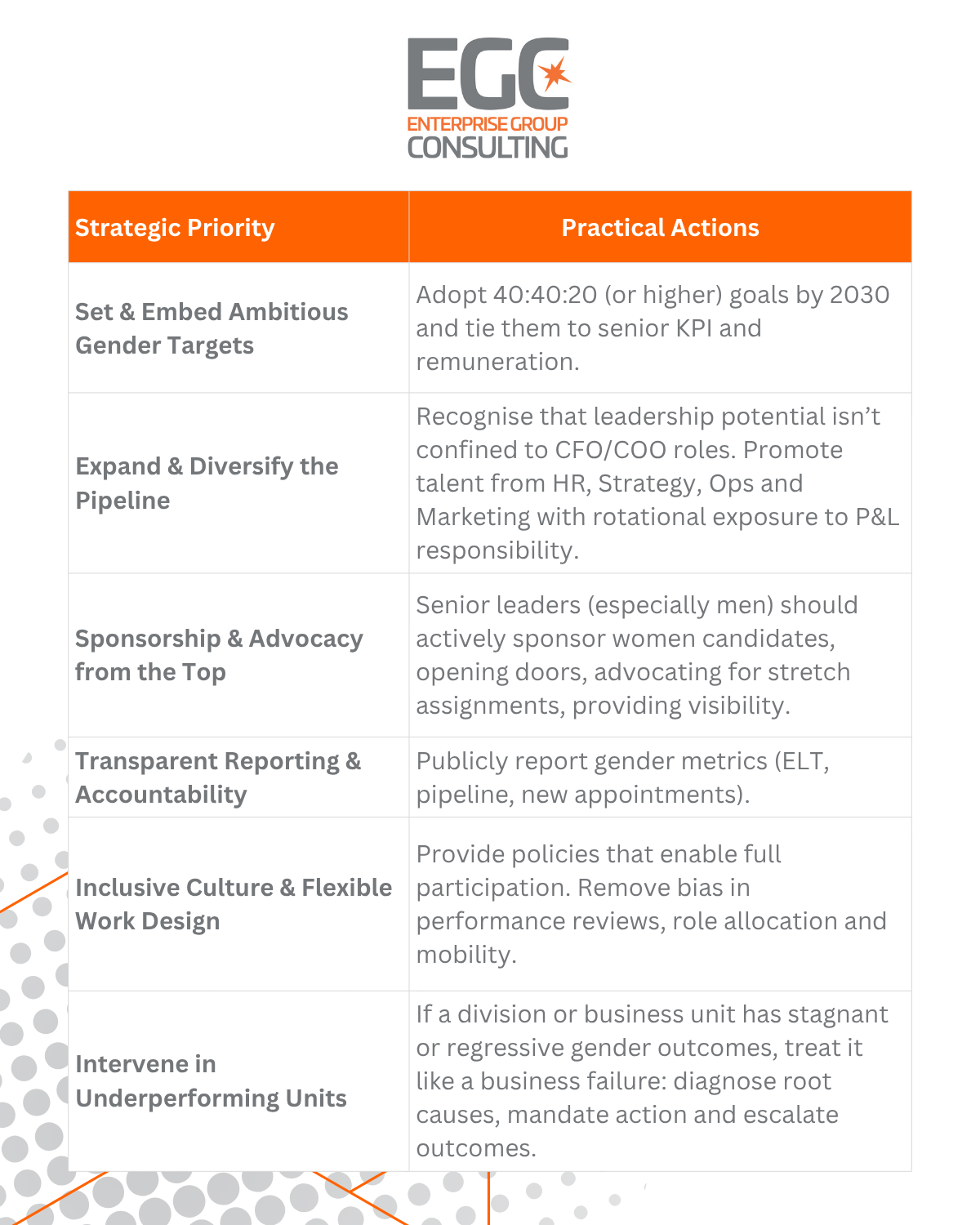Insight
Australia’s Uneven Pace of Change in Corporate Leadership

In September 2025, Chief Executive Women (CEW) released its Senior Executive Census 2025, the ninth iteration of its landmark tracking of women’s representation in Australia’s top publicly listed companies (ASX 300). The latest data reveals a sobering truth: despite nearly a decade of reporting and advocacy, gender equity in executive leadership is still advancing at a glacial pace and in many cases, stalling.
Measurement is essential, but not sufficient. The Census underscores that to move from awareness to impact, companies must embed accountability and stretch commitments into performance. Below is our take on the report’s key themes, standout statistics and what leaders must do next.
9 in 10 CEOs Are Men
- Across the ASX 300, 69 % of Executive Leadership Team positions remain held by men, leaving just 31 % held by women.
- In critical “CEO pipeline roles” (CEO, Group Executive, COO, CFO), 80 % are held by men.
- Only 27 female CEOs now lead ASX 300 companies - meaning 9 in 10 CEOs are men.
- Shockingly, 41 % of ASX 300 companies have no women in CEO pipeline roles at all.
- Worse, 18 companies operate without a single woman in executive leadership, down only slightly from 2024.
- Far too many organisations have regressed: one-quarter of ASX 300 firms saw declines in women’s representation within leadership this year.
What Moves the Needle: Targets & Accountability
The Census sheds light on the difference-makers. The companies that are making headway tend to share structural features:
- Target-setting matters. Organisations that have adopted 40:40 (or better) gender balance targets are 2.7× more likely to achieve gender-balanced leadership than those without targets.
- Only 44 % of ASX 300 firms currently have 40:40 (or better) targets in place - a modest increase from previous years.
- In the ASX 100, adoption is stronger: 59 % have set 40:40 goals.
- Companies led by female CEOs outperform in gender balance: they average 46 % women in leadership, compared to 31 % across all companies.
These data points reinforce a simple truth: intentions must be operationalised. Without tangible metrics, targets, and accountability, corporate gender equity often remains symbolic.
Structural Barriers & Pipeline Constraints
Beyond surface metrics, the Census interrogates why progress is so slow and points to deep, structural constraints.
The Pipeline Is Narrow, Not Leaky
Many women reach executive roles in functions such as HR, Legal or Corporate Affairs; roles essential to business but not typically considered the “front door” to the CEO track. Consequently:
- 66 % of female executives occupy non-pipeline roles, limiting their promotion prospects.
- In many companies, non-pipeline roles dominate women’s presence, masking the more critical gap in roles with P&L responsibility - CFO, COO, etc.
- In some sectors (Utilities, Real Estate), female representation in pipeline roles is almost non-existent.
Sector & Corporate Size Gaps
- The ASX 100 outperform smaller ASX cohort peers in both representation and adoption of targets.
- In industries such as Information Technology, Materials, Utilities, female executive and pipeline representation is particularly weak.
- Some companies with zero women at the executive level tend to be smaller, lack targets or are in sectors with traditional gender imbalances.
Leadership Biases & Cultural Inertia
- The Census reaffirms that awareness alone is insufficient: for nearly ten years, CEW data has been available yet change remains slow.
- CEW and commentators argue that lack of accountability, weak performance linkage and narrow definitions of “leadership potential” contribute to the stagnation.
- In media and public commentary, CEW has called for tying gender targets to executive pay to prevent equality from being treated as optional.
The Economic Imperative
Beyond social justice, the economic repercussions are significant. The Census and CEW point to compelling evidence:
- Companies with diverse executive teams are more likely to outperform.
- Australia reportedly could unlock AUD 128 billion in GDP by better utilising female talent.
- The slow pace of change suggests many top companies are missing the opportunity cost of not having women in decision-making roles.
As a sector-wide trend becomes entrenched, organisations that lead in gender equity will have a competitive advantage in talent, reputation, innovation and adaptability.
What Leading Organisations Are Doing (or Should Do)
Based on the Census, CEW recommendations and observed patterns, here’s what enterprise leaders should prioritise to shift from slow drift to accelerating change:
Set and Embed Ambitious Gender Targets
Adopt 40:40:20 (or higher) goals by 2030 and tie them to senior KPI and remuneration. CEW finds companies with targets are 2.7× more likely to succeed.
Expand & Diversify the Pipeline
Recognise that leadership potential isn’t confined to CFO/COO roles. Promote talent from HR, Strategy, Ops, Marketing. Rotational exposure to P&L responsibility is critical.
Sponsorship & Advocacy from the Top
Senior leaders (especially men) should actively sponsor women candidates, opening doors, advocating for stretch assignments, providing visibility.
Transparent Reporting & Accountability
Publicly report gender metrics (ELT, pipeline, new appointments). Use dashboards. Hold business units accountable for progress.
Inclusive Culture & Flexible Work Design
Provide policies that enable full participation like flexible hours, caregiving support, inclusive norms. Remove bias in performance reviews, role allocation and mobility.
Intervene in Underperforming Units
If a division or business unit has stagnant or regressive gender outcomes, treat it like a business failure: diagnose root causes, mandate action and escalate outcomes.

From Census to Culture Shift
The 2025 CEW Senior Executive Census is less a celebration of progress and more a call to action. Its narrative is sobering, its numbers stark, but they also clarify where leverage lies.
- Awareness campaigns alone are no longer enough.
- Corporate leadership must shift from optional support to baked-in accountability.
- Organisations that treat gender equity as a strategic imperative — not a checkbox — will not just lead in fairness but in performance.
At Enterprise Group Consulting, we’re committed to translating data into action. We believe the future of corporate Australia depends on ensuring that every voice has access to the table. The Census gives us the map. It’s time we work with urgency to navigate toward that more equitable horizon.
Share This Article
Recent Articles




Archive












